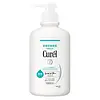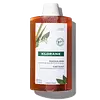What's inside
What's inside
 Key Ingredients
Key Ingredients

No key ingredients
 Benefits
Benefits

 Concerns
Concerns

 Ingredients Side-by-side
Ingredients Side-by-side

Dipotassium Glycyrrhizate
HumectantWater
Skin ConditioningSodium Laureth Sulfate
CleansingLauryl Hydroxysultaine
CleansingC9-11 Alkyl Glucoside
CleansingPPG-10 Lauryl Ether
PPG-3
SolventTrehalose Hydroxypropyltrimonium Chloride
Skin ConditioningBenzyl Benzoate
AntimicrobialCoconut Oil Aminoethoxyethanol Amides
FoamingSodium Cocoyl Glutamate
CleansingCitric Acid
BufferingDiallyldimethyl Ammonium Chloride
Stearoxymethicone/Dimethicone Copolymer
EmollientAlcohol Denat.
AntimicrobialEDTA
Sodium Chloride
MaskingSodium Hydroxide
BufferingOrange Roughy Oil
Skin ConditioningEucalyptus Globulus Oil
Dipotassium Glycyrrhizate, Water, Sodium Laureth Sulfate, Lauryl Hydroxysultaine, C9-11 Alkyl Glucoside, PPG-10 Lauryl Ether, PPG-3, Trehalose Hydroxypropyltrimonium Chloride, Benzyl Benzoate, Coconut Oil Aminoethoxyethanol Amides, Sodium Cocoyl Glutamate, Citric Acid, Diallyldimethyl Ammonium Chloride, Stearoxymethicone/Dimethicone Copolymer, Alcohol Denat., EDTA, Sodium Chloride, Sodium Hydroxide, Orange Roughy Oil, Eucalyptus Globulus Oil
Water
Skin ConditioningDisodium Laureth Sulfosuccinate
CleansingDecyl Glucoside
CleansingLauryl Betaine
CleansingCeteareth-60 Myristyl Glycol
EmulsifyingLactic Acid
BufferingPentylene Glycol
Skin ConditioningAlpinia Galanga Rhizome Extract
Skin ConditioningParfum
MaskingLaureth-3
EmulsifyingMaleic Acid
BufferingMaltodextrin
AbsorbentOleth-10
EmulsifyingPolyquaternium-22
CI 17200
Cosmetic ColorantSodium Benzoate
MaskingSodium Chloride
MaskingSodium Hydroxide
BufferingTocopherol
AntioxidantWater, Disodium Laureth Sulfosuccinate, Decyl Glucoside, Lauryl Betaine, Ceteareth-60 Myristyl Glycol, Lactic Acid, Pentylene Glycol, Alpinia Galanga Rhizome Extract, Parfum, Laureth-3, Maleic Acid, Maltodextrin, Oleth-10, Polyquaternium-22, CI 17200, Sodium Benzoate, Sodium Chloride, Sodium Hydroxide, Tocopherol
 Reviews
Reviews

Alternatives
Ingredients Explained
These ingredients are found in both products.
Ingredients higher up in an ingredient list are typically present in a larger amount.
Chances are, you eat sodium chloride every day. Sodium Chloride is also known as table salt.
This ingredient has many purposes in skincare: thickener, emulsifier, and exfoliator.
You'll most likely find this ingredient in cleansers where it is used to create a gel-like texture. As an emulsifier, it also prevents ingredients from separating.
There is much debate on whether this ingredient is comedogenic. The short answer - comedogenic ratings don't tell the whole story. Learn more about comegodenic ratings here.
The concensus about this ingredient causing acne seems to be divided. Research is needed to understand if this ingredient does cause acne.
Scrubs may use salt as the primary exfoliating ingredient.
Learn more about Sodium ChlorideSodium Hydroxide is also known as lye or caustic soda. It is used to adjust the pH of products; many ingredients require a specific pH to be effective.
In small amounts, sodium hydroxide is considered safe to use. However, large amounts may cause chemical burns due to its high alkaline.
Your skin has a natural pH and acid mantle. This acid mantle helps prevent harmful bacteria from breaking through. The acid mantle also helps keep your skin hydrated.
"Alkaline" refers to a high pH level. A low pH level would be considered acidic.
Learn more about Sodium HydroxideWater. It's the most common cosmetic ingredient of all. You'll usually see it at the top of ingredient lists, meaning that it makes up the largest part of the product.
So why is it so popular? Water most often acts as a solvent - this means that it helps dissolve other ingredients into the formulation.
You'll also recognize water as that liquid we all need to stay alive. If you see this, drink a glass of water. Stay hydrated!
Learn more about Water